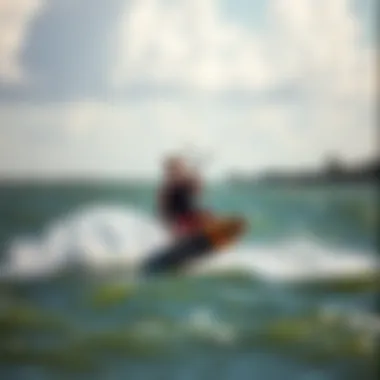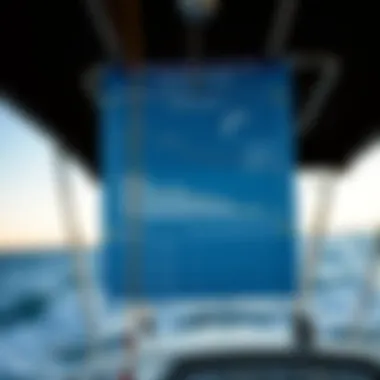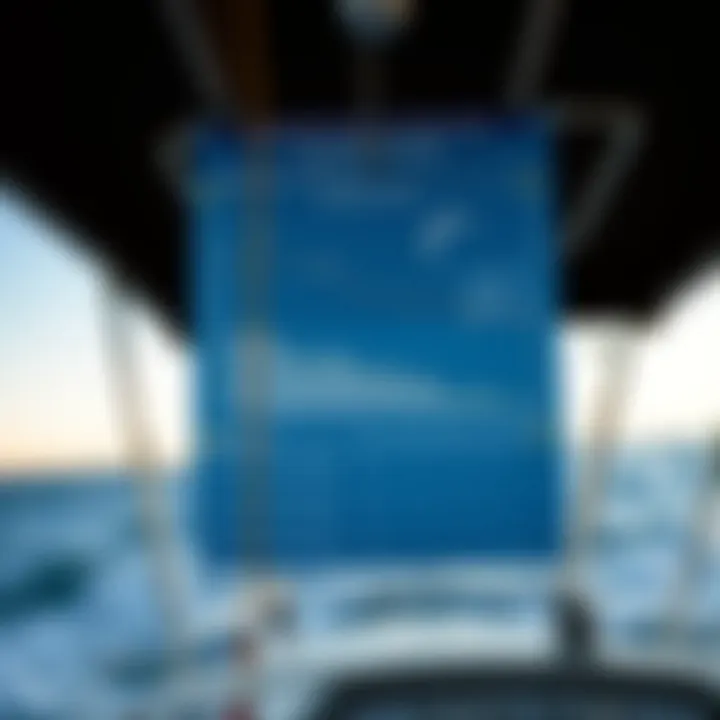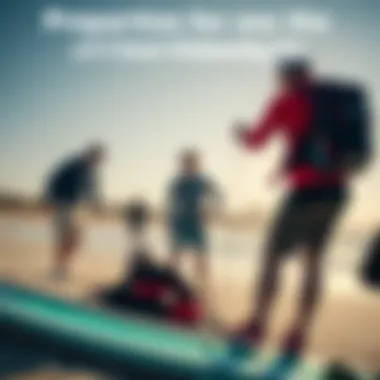Understanding the JAX Marine Forecast for Kiteboarding


Intro
Understanding marine forecasts, especially the one specific to JAX, is pivotal for kiteboarding enthusiasts. Whether you're a novice just dipping your toes into the sport or a seasoned rider looking to fine-tune your craft, awareness of weather and tidal patterns can’t be overstated. As wind conditions vary throughout the day, knowing what's happening on the water can mean the difference between a joyful ride and a risky venture.
This guide aims to shed light on the intricacies of the JAX marine forecast while providing insights into vital components that enhance your kiteboarding experience. The significance of these forecasts extends beyond simply knowing when to hit the waves; they play an essential role in ensuring safety and optimizing enjoyment out on the water. With various facets to consider, from weather patterns to expert tips, this article brings a wealth of information to help you navigate the great outdoors with confidence.
As each section unfolds, we’ll explore different elements relevant to kiteboarding, supercharging your skills and enhancing your safety measures. After all, knowledge is the wind beneath your wings when gliding across the water.
Gear and Equipment
Having the right gear can make or break your kiteboarding experience. It’s not just about flying high; it’s about flying smart. Each kiteboarder’s equipment needs and preferences vary, so understanding what works best in different conditions can enhance performance.
Essential Kiteboarding Gear for Beginners
- Kite: For those new to kiteboarding, a beginner-friendly kite—typically larger with a suitable aspect ratio—offers more lift and stability. Brands such as Cabrinha and North Kiteboarding provide options that are great for novices.
- Board: A wider board is beneficial for beginners as it provides better flotation, making it easier to stay up when navigating choppy seas. You might want to look at models like the Slingshot Wizard.
- Harness: A comfortable and supportive harness is a must. It should fit snugly without restricting movement.
- Safety Gear: A helmet, impact vest, and sometimes a buoyancy aid can give you peace of mind while you're learning the ropes, or in this case, the kites.
- Bar and Lines: Your control bar should be user-friendly and not overly complex, making it easier to react quickly.
Being armed with the right equipment ensures your time on the water is not only fun but also safer.
Advanced Equipment for Experienced Riders
As you progress in your kiteboarding journey, diversifying your gear becomes essential. Experienced riders often favor:
- High-Performance Kites: Look for models by brands such as Ozone and F-One. These kites pull with precision in varying conditions, adjusting to heat and gusts more delicately.
- Specialty Boards: Riders may opt for freestyle or surf-style boards depending on their preferred kiteboarding style. Some even customize their boards for optimized performance on specific water types.
- Advanced Harnesses: Many seasoned kiteboarders switch to seat harnesses for better control and support during high-speed maneuvers.
- Advanced Safety Gear: A quick-release mechanism becomes vital as trick complexity increases. Ensuring you have reliable equipment could help avoid troublesome situations.
By continuing to invest in high-quality gear, you’ll find that your skills improve, allowing for an exhilarating kiteboarding experience to unfold as you ride the waves with confidence and flair.
"The essence of kiteboarding lies in the elements - understanding them makes all the difference between a great experience and a disaster."
As we move forward, it’s vital to dive into the nuances of techniques and tips that keep you flying high and riding smooth.
Preface to JAX Marine Forecast
Navigating the sprawling waters for kiteboarding can feel as chaotic as a game of chess played on a rollercoaster. A well-thought-out marine forecast, particularly one tailored for regions such as JAX, is crucial. It doesn't just serve kiteboarders; it's like having a seasoned guide in your back pocket guiding your voyage.
Understanding Marine Forecasts
Marine forecasts, in essence, are structured blends of meteorological data and specific marine environments aimed at illustrating various weather conditions. They provide comprehensive insights into what one can expect at sea or along coastal areas. By evaluating aspects like wind speed, temperature, and wave heights, kiteboarders are better positioned to make informed choices. It's kind of like studying a road map before embarking on a long drive – if you know the routes and any possible obstacles, you're setting yourself up for success.
Popular marine forecasts typically include innumerable details, like:
- Wind Conditions: Vital for powering the sail and maneuvering through the waves.
- Wave Heights: Tells you whether you're in for gentle swells or a wild ride.
- Temperature Fluctuations: Helps in packing the right gear to stay comfortable.
- Tide Times: Navigating at high tide can make a world of difference.
Importance for Kiteboarding
For kiteboarders, the importance of a detailed marine forecast cannot be overstated. Kiteboarding is a sport that’s heavily reliant on the interplay of several weather elements. A wrong gust of wind or an unexpected change in tide can quickly turn a triumph into a near disaster.
- Safety First: A good grasp of marine conditions ensures you paddle out rather than getting swept away. As an example, knowing when high tide peaks can provide a safer space for beginners.
- Optimized Experience: Kiteboarding in optimal conditions enhances skill levels. A forecast that predicts favorable wind conditions can elevate the thrill of the ride, unlocking higher jumps and better tricks.
- Community Engagement: Kiteboarding is not just an individual sport; it fosters community. Being well-informed encourages kiteboarders to participate in group outings and events, sharing the thrill with like-minded individuals.
The key takeaway here is using a marine forecast can act like a crystal ball for kiteboarders, offering glimpses into demanding conditions, enhancing both experience and safety on the water.
In summary, understanding the components and value of the JAX Marine Forecast is an essential part of any kiteboarder's toolkit. By honing in on various elements affecting marine conditions, enthusiasts pave the way for a more exciting, secure kiteboarding journey.
Components of the JAX Marine Forecast
Understanding the components of the JAX Marine Forecast is crucial for anyone looking to enjoy kiteboarding or any marine activity. Each element can significantly impact the conditions you face on the water, and knowing how to interpret these components can mean the difference between a thrilling day or an unfortunate one. The major components include wind conditions, wave heights, precipitation and temperature, as well as tidal patterns. Familiarity with these aspects helps kiteboarders optimize their sessions and prioritize safety.
Wind Conditions
Wind serves as the driving force behind kiteboarding. For kiteboarders, the forecast details wind speed and direction, both of which are pivotal in determining how effectively one can ride. Typically, wind speeds are categorized as light, moderate, or strong, influencing the size of the kite you should use.


- Light Wind (0-10 knots)
A light wind day may require a larger kite to maintain lift. If you're an inexperienced rider, it could make for a frustrating experience as you may struggle to stay on the board. - Moderate Wind (10-20 knots)
This is generally considered optimal for experienced kiteboarders. It allows for maximum performance while still providing a safety buffer against overpowered situations. - Strong Wind (20+ knots)
Riders should be cautious with strong winds, as they can easily lead to losing control. Adjusting your technique or kite size is essential here.
Understanding the wind's direction is also key; onshore winds can make it easier to ride out, whereas offshore winds may pose risks of being blown away from the shoreline.
Wave Heights
Wave conditions are another critical aspect of the JAX Marine Forecast. Waves can drastically affect the ride experience, and irrespective of skill level, knowing how to read this can save you from a bumpy ride.
- Small Waves (0-1 foot)
Ideal for beginners, flat water conditions mean less chop and are more forgiving. - Moderate Waves (1-3 feet)
Provide a bit of excitement, perfect for those looking to practice jumps without being too risky. - Large Waves (3+ feet)
Advanced riders might enjoy the thrill, but novices are typically advised to steer clear due to potential hazards.
Pay attention to the intervals between waves as well; shorter intervals may indicate choppier water conditions.
Precipitation and Temperature
Understanding precipitation is vital, as wet conditions can greatly impact visibility and safety. Rain can obscure your sight and even affect the kite’s material over prolonged exposure. The temperature also plays a role; warmer days are inviting, but if rain is paired with cooler temps, it can lead to discomfort or hypothermia.
Here’s what to keep in mind:
- Rain Conditions
Light showers may not significantly dampen your ride, but sustained downpours warrant caution. - Temperature Drops
If the forecast predicts a temperature drop in conjunction with rain, consider wearing layers to maintain warmth.
Tidal Patterns
Tidal patterns can change the entire landscape of the kiteboarding experience. Understanding when high or low tides will occur can help you pinpoint the best times to hit the water.
- High Tide
This can bring in smooth water conditions and possibly increase the height of waves. - Low Tide
May expose sandbars or rocky areas that can be hazards for less experienced riders.
Kiteboarders should always check tidal schedules, as timing your session around these factors can enhance safety, accessibility, and enjoyment on the water.
By recognizing the components of the JAX Marine Forecast, kiteboarders can make informed decisions, improving their overall kiteboarding experiences and maximizing safety on the water.
How to Read the JAX Marine Forecast
Understanding how to interpret the JAX Marine Forecast is paramount for kiteboarders and other water sports enthusiasts. As many know, conditions out on the water can shift like quicksand. A mastery of the forecasts can mean the difference between sailing like the wind and paddling against the tide. Knowing the whereabouts of gusty winds, swells, and even the unpredictable rain can help in planning a day that’s smooth sailing.
Deciphering Weather Symbols
Weather symbols in the JAX Marine Forecast serve as a visual shorthand for the conditions expected on the water. These symbols can quickly convey essential information without the need for lengthy explanations. For instance, a cloud with raindrops signifies precipitation, while a sun symbol usually indicates clear skies.
When scanning the forecast, kiteboarders should pay particular attention to:
- Wind Direction: Often indicated by arrows, the direction from which the wind is blowing can offer insights into the sea conditions.
- Wind Speed: Various icons might display different speed ranges. A gentle breeze means ease while a shifted icon might suggest a stronger wind, compelling for more experienced kiteboarders.
- Wave Heights: Symbols representing wave heights help assess whether it's safe or enjoyable to hit the water.
Being familiar with these symbols can enhance your comprehension of the forecast at a glance. It streamlines decision-making, allowing you to focus on what matters, rather than getting lost in the details.
"Weather symbols are not just pictures; they tell a story of what to expect on your adventure."
Understanding Technical Terminology
The technical jargon often found in marine forecasts can seem daunting at first glance, but grasping this language is vital for maximising your time on the water. Terms like 'barometric pressure' or 'isobar' are keys to unlock deeper knowledge about the weather patterns affecting your kiteboarding session.
Some critical terms to become familiar with include:
- Barometric Pressure: Affects wind and storm development; a drop often means trouble ahead.
- Tide Levels: Indicates how high or low water will be, impacting your launch spots.
- Gusts: Refers to short bursts of wind that can affect your control on the water.
- Squall: A sudden increase in wind speed, often accompanied by rain. Being aware of this can prevent unexpected mishaps.
Understanding these terms can cultivate a more comprehensive perspective about what you're diving into. It helps to make informed choices about when to take your kite out and when to keep your feet on solid ground. So, take the time to familiarize yourself with the language—doing so will pay off in spades.
In essence, the ability to read the JAX Marine Forecast is an essential skill for every kiteboarder. It allows not only for better planning of your sessions but also enhances your safety on the water.
Practical Applications of Marine Forecasts


Understanding how to effectively utilize marine forecasts can make a world of difference, especially for kiteboarding enthusiasts. It isn’t just about knowing when it’s sunny or rainy. Having the right information at your fingertips allows for more than just decent leisure time; it’s about safety, excitement, and making the most out of each session on the water.
Planning Kiteboarding Sessions
When it comes to kiteboarding, timing truly is everything. A clear grasp of marine forecasts can help you pinpoint the most advantageous conditions for your adventure. Here are a few crucial elements:
- Optimized Wind Patterns: Knowing how strong and which direction the wind will blow can determine how thrilling your ride will be. For example, a consistent 15-20 knots from the east might be just right, while gusty winds may not be ideal.
- Wave Heights: Understanding the predicted wave conditions is paramount. A forecast showing 1-2 foot waves is usually perfect for those who aim for less intensity, while more experienced riders might thrive looking for larger swells.
- Tides: Checking tidal patterns is essential too. A rising tide might create more favorable shoals or unique wave setups, enhancing the overall experience.
Consider the use of forecasting apps or websites, like Windy or Magicseaweed, that offer real-time updates. This information can be worth its weight in gold. You can ensure you're hitting the water at peak times, making each trip both enjoyable and exhilarating.
Assessing Safety Risks
While the thrill of kiteboarding certainly has its allure, it’s important not to dip your toes in without checking the safety landscape first. Marine forecasts are an invaluable tool for understanding potential hazards.
- Weather Changes: Rapid shifts in weather can pose risks, such as thunderstorms or heavy rain. A thorough read of the forecast helps you spot these changes before they turn into a serious issue.
- Wind Gusts and Directions: Variables in wind—sudden gusts or shifting directions—can dictate safety on the water. Forecasts may indicate that wind is at a safe level, but if that could change quickly, it’s worth being alert and prepared.
- Visibility Concerns: Poor visibility, either due to precipitation or fog, could lead to mishaps. Incorporating the precipitation report from the forecast into your planning ensures you remain within safe limits.
Keep in Mind: Always trust your instincts! If a forecast looks off and you feel uneasy, it might be best to stay off the water that day.
By carefully assessing forecasts, kiteboarders can dramatically lower their risk of accidents, ensuring a much safer experience on the waves. Taking the time to interpret these forecasts can be a game-changer, transforming your kiteboarding sessions from ordinary to extraordinary while keeping safety in sharp focus.
For further insights, websites like NOAA (http://noaa.gov) and local government marine advisories provide detailed and trusted information.
Incorporating these practices makes you much more than a kiteboarder; it turns you into a savvy water-sports aficionado. By making informed decisions, you enhance not just your experience but also those around you, creating a communal culture of safety and enjoyment.
Limitations of the JAX Marine Forecast
While the JAX marine forecast serves as a vital tool for kiteboarders and outdoor enthusiasts, it isn’t without its drawbacks. Understanding the limitations of these forecasts is crucial for making informed decisions on the water, as reliance on them can lead to unexpected challenges. Here, we delve into two principal limitations that bear particular significance.
Forecasting Errors
Forecasting errors can occur for several reasons. Just as a chef may miscalculate cooking time in a recipe, meteorologists face the tough task of predicting the rapidly changing behavior of weather. The accuracy of marine forecasts can fluctuate based on several factors:
- Data Quality: The models rely heavily on the quality and volume of the data collected, which sometimes suffers due to gaps in local observation stations or equipment malfunctions.
- Model Limitations: Different forecasting models utilize various parameters. If the model chosen for the JAX forecast lacks detail or is based on outdated algorithms, it may predict inaccurate outcomes, similar to cooking with stale ingredients.
- Geographic Variability: Coastal environments, known for their dynamic climates, can cause unpredictability in forecasts. For kiteboarders, what works at one beach may differ at another, owing to local topography and conditions.
These errors underscore the necessity of cross-referencing forecasts using multiple trustworthy sources. Familiarizing oneself with different forecasts can greatly reduce the risk of getting caught in unfavorable weather conditions.
Changing Weather Patterns
Weather patterns are not as stable as a well-tied knot. The nature of climate change and shifting weather systems can unleash unexpected curveballs, impacting the reliability of any forecast. Here are a few key considerations:
- Long-Term Trends: Observational data shows that as climate patterns become erratic, longstanding trends in temperature and weather may begin to vanish. A forecast that worked last season may not apply this year. Staying informed and adaptable is essential for safe kiteboarding practices.
- Local Anomalies: Weather can behave whimsically. Sometimes, localized storm systems can pop up without much warning, making forecasts potentially unreliable. Kiteboarders should remain vigilant and flexible, ready to change plans if conditions begin to shift more dangerously than anticipated.
- Quick Changes: From sunny skies suddenly turning to stormy weather in a blink, the pace of weather changes can easily catch anyone off guard. Quick adaptation and a retrospective view of forecasts can assist in addressing these sudden shifts.
"Being prepared means always having an alternative plan, as Mother Nature can change her mind at the drop of a hat."
Resources for Further Information
Navigating the waters, especially for kiteboarders, requires not just skill and equipment but also accurate information. The JAX Marine Forecast is a cornerstone for ensuring a safe and enjoyable experience on the water. However, relying solely on this forecast might not be enough. Therefore, it becomes essential to delve into additional resources that can provide a more complete picture of current and forthcoming marine conditions.
The significance of supplementary resources lies in their capacity to enhance understanding and decision-making. Online platforms and local weather stations can offer real-time updates, detailed data analysis, and localized insights that are crucial for kiteboarding enthusiasts. In times where weather can change on a dime, these resources are not merely helpful—they're vital for ensuring that kiteboarders are well-prepared and informed.
Online Platforms and Apps
The digital era has fundamentally changed how we approach marine and weather forecasts. Numerous online platforms and mobile applications have emerged, each offering unique features tailored to the kitesurfing community.
For instance, Windy is an app well-loved by many kiteboarders. It provides users with live updates on wind conditions, wave heights, and even precipitation forecasts. The visual representation on the map allows kiteboarders to spot the best spots to ride with just a glance.
Other noteworthy platforms include:
- Magicseaweed: This site is particularly renowned for surf reports but is equally useful for kiteboarders, giving insights on tide movements and swell predictions.
- Windfinder: It specializes in wind forecasts and is popular among outdoor sports enthusiasts. Users can see wind speeds and directions predicted for specific locations.
- National Oceanic and Atmospheric Administration (NOAA): Their website offers data straight from the source, which can be essential for a comprehensive understanding of coastal conditions.


Users should pay attention to mobile notifications or alerts that these apps provide, as they often patch into real-time data to keep you updated on any rapid weather changes.
"When it comes to being out on the water, knowledge isn't just power—it's safety."
Local Weather Stations
While apps and websites can provide excellent data, sometimes the most trusted information comes from local weather stations. These institutions often have dedicated resources aimed specifically at marine conditions. Many coastal areas, including those around JAX, offer reports tailored for sailors and kiteboarders alike.
Local weather stations tend to have:
- Localized forecasts: They contribute accurate data for specific communities rather than general trends, making them an invaluable resource.
- Equipment: Many stations utilize state-of-the-art meteorological instruments that can detect minute changes in wind and weather patterns.
- Community insights: Often, local stations are staffed by people who understand the area well and can provide anecdotal data alongside scientific reports.
To find local weather station updates, kiteboarders can check out websites like:
- The Weather Channel: Their local radar can pinpoint specific locations.
- AccuWeather: This site provides finely-tuned reports for different regions.
- Local news stations: Often have dedicated weather segments focusing on marine activities.
In summary, while the JAX Marine Forecast remains an essential tool, supplementing it with resources like online platforms and local weather stations can enhance your kiteboarding experiences—ensuring you remain safe while chasing those exhilarating winds.
Expert Insights on Marine Forecasts
Understanding the JAX Marine forecast requires looking beyond surface-level information; it calls for insights from those who live and breathe the sport. Keen perspectives from experienced kiteboarders and marine weather specialists can illuminate the intricacies of weather forecasting, translating technical jargon into actionable knowledge for outdoor enthusiasts.
These insights not only enhance practical understanding but also foster a sense of community. Regular input from kiteboarding professionals sheds light on specific challenges faced in various conditions. When seasoned riders share their stories, they fundamentally elevate the collective comprehension of marine forecasts.
Interviews with Kiteboarding Professionals
Engaging with professionals who make their living on the water offers rich, first-hand evidence of how the JAX Marine forecast influences decision-making in kiteboarding. For instance, consider a prominent kiteboarder based in Jacksonville who actively monitors local forecasts before heading out.
In a candid interview, she reveals how "knowing the wind speed isn’t just numbers—it’s the difference between struggling in gusty conditions and enjoying seamless rides." Her advice revolves around paying attention to both sustained wind values and gust forecasts, which can change dramatically within short timeframes.
Here are some key takeaways from her experiences:
- Daily Forecast Reviews: She emphasizes checking forecasts daily as wind conditions can shift rapidly.
- Climatic Patterns: She discusses how early season trends can indicate prevailing winds, suggesting that historical data becomes essential for long-term planning.
- Local Knowledge: Tapping into local expertise can make or break a successful kiteboarding session, as subtle shifts in weather patterns can impact spots directly.
By blending technical understanding with personal experiences, these insights make the often-technical forecasts approachable and relevant.
Case Studies of Forecast Impact
The real-world implications of marine forecasts on kiteboarding cannot be overstated. By examining specific cases, one can better appreciate how predictive accuracy or misfortune plays out on the water.
Take, for example, two contrasting days in Jacksonville's kiteboarding history—one rock-solid forecast versus unexpected weather behavior. On a recorded summer afternoon, the forecast indicated consistent 15 mph winds with minimal gusting. Kiteboarders flocked to the beach knowing conditions were prime. The result? A near-perfect day, packed with smooth rides and shared camaraderie, fulfilling the hopes of many.
Conversely, another well-documented instance involved an errant forecast claiming clear conditions, but meteorological anomalies led to squalls that rolled through without notice. Kiteboarders found themselves battling sudden storms, prompting an emergency scramble upwind.
The ups and downs highlighted the importance of:
- Evaluating Notifications: Continuous updates from the JAX Marine forecast allowed many to navigate tricky situations somewhat effectively.
- Understanding the Limits of Forecasts: This incident served as a vital reminder that inherent uncertainties in forecasting can still catch even seasoned individuals off guard.
Culmination
In this closing section, it's essential to emphasize the significance of understanding the JAX Marine Forecast for kiteboarders and outdoor enthusiasts alike. As we've explored throughout the article, marine forecasts are not just dry statistics or data points. They hold the key to ensuring not only a pleasant day on the water but also a safe one.
Kiteboarding, with its dynamic nature, demands that riders pay close attention to weather patterns, wind speed, and tide issues. Successfully interpreting these forecasts enhances the kiteboarding experience, allowing enthusiasts to make informed decisions on when and where to ride. Engaging with the marine forecast not only fosters skills in analyzing weather conditions but also encourages safer practices.
Moreover, the knowledge gleaned from these forecasts can literally make the difference between a fantastic day out and a risky situation. With wild winds or unexpected rain showers, even the most seasoned kiteboarders can find themselves caught off guard. Hence, integrating marine forecasts into the planning stages of any kiteboarding journey is critical.
Summary of Key Points
- Understanding the JAX Marine Forecast leads to better decision-making for kiteboarders.
- Familiarity with wind conditions, wave heights, and tidal patterns is crucial.
- The potential for enjoyable experiences increases while the risk of accidents decreases with accurate weather insights.
- Accessibility to resources, such as local weather stations or apps, can equip riders for any situation.
Final Thoughts for Kiteboarders
In closing, the JAX Marine Forecast is not just a tool—it's an essential companion for every kiteboarding adventure. The more you engage with it, the more adept you become at reading the signs that nature presents. Consider this knowledge a vital part of your kiteboarding toolkit. Keep practicing, keep analyzing, and enjoy every moment out on the waves. The ocean offers both challenge and thrill, but with the right information at hand, you can navigate it with confidence.
"Knowledge is not only power but also peace of mind."
For further information, consider visiting resources such as NOAA, WUnderground for accurate weather updates, and consult various kiteboarding forums on Reddit for community insights.















